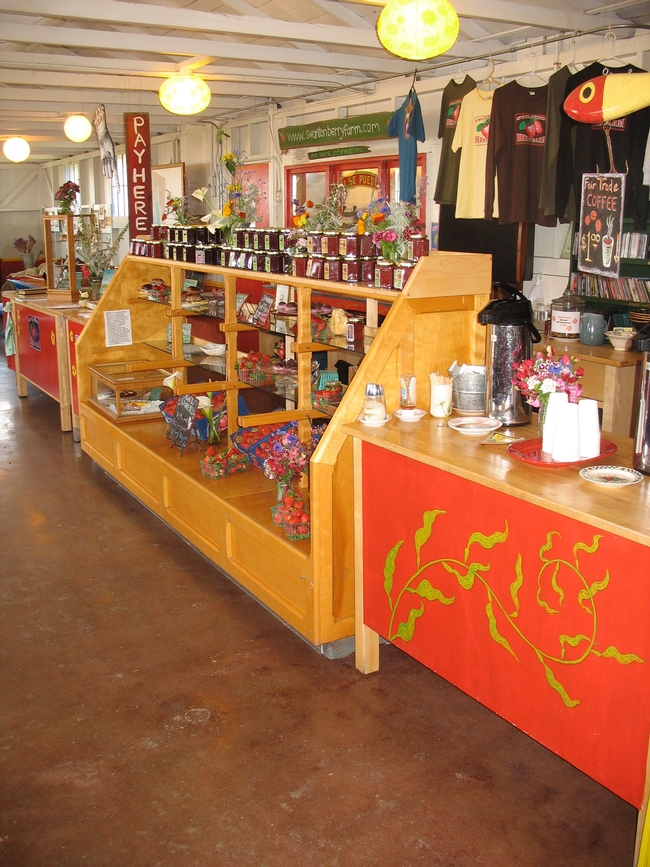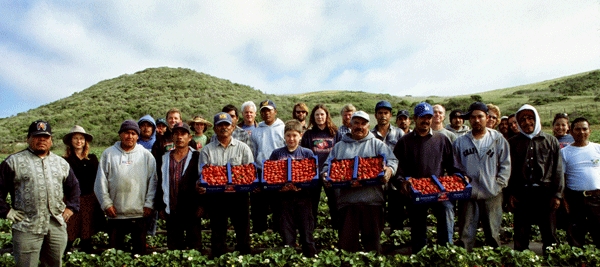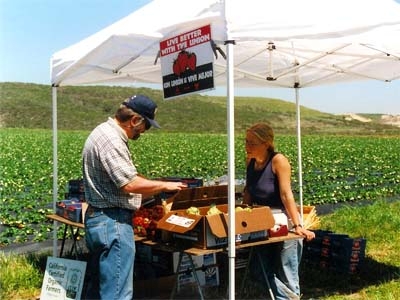Posts Tagged: blackberries
U-pick organic strawberry season opens on coast
The U-pick strawberry fields at Swanton Berry Farm near Davenport on the coast are formally opening on May 28, but if you drive out there now, you’ll get a chance to pick without a crowd. Talking to Barrett Boaen, the U-pick manager, I got to the bottom of just why their berries, also sold at local Whole Foods stores, look and taste so good.
Partly it’s the ‘Chandler’ variety, chosen for its old-fashioned sweetness and flavor although it yields only about two-thirds as well as some varieties. It’s also about not pumping up production with too much nitrogen or irrigation (more details here). Mostly, though, it’s about the picking process. A strawberry grower visiting from the East Coast recently bought two flats from the farmstand, saying he couldn’t help himself, he had never laid eyes on such beautiful organic berries, and he knew who to congratulate—the pickers.
You and I are unlikely to come close to picking as well as Swanton’s unionized employees, some of whom have more than 20 years of experience at the farm. They recognize when a strawberry is as ripe as it can be, when it’s red and sweet all the way through (strawberries don’t continue ripening once they are picked). Although a less ripe berry is firmer, with a longer shelf-life and easier to transport, it has less flavor, so the pickers wait a day or two for any berry with a green tip or white shoulders to ripen perfectly. They discard berries that are soft on one side (from raindrops settling on the fruit) or have a cat-face look, which is lygus bug damage.
Moving along the rows, which are banked up to 18 inches high to reduce back strain, they harvest each perfectly ripe berry, with its green calyx attached, in a “twist and flick” motion: “you put tension on the stem above the calyx, and rotate it, so you can see 360 degrees and whether there’s any damage to the berry; then with just the right tension, the berry will pop off naturally,” explains Boaen.
In the U-pick fields, which have ocean views, visitors pick for pleasure, hopping from row to row, enjoying the fresh air, and the fragrance of the berries and the earth. Compared to the serious work in the other 20 acres of strawberries, “the 3 acres of U-pick are a playground,” says Boaen, “We provide people everything they need to be happy.”
“It can be demoralizing,” Boaen admits. “All that energy put into the fruit after the excellent warm January was wrecked.”
Fortunately, the farm has several other crops, and the strawberry fields are filling with new berries. You can pick them this summer for $2.50 per pound (10 percent discount for bicyclists). Bring your own containers if you remember, a windproof jacket and boots in case of fog or mud, and most of all, Boaen recommends allowing plenty of time to enjoy yourself.
By mid-June, Swanton ollalieberries will be ripe, and by mid- or late July, the blackberries will be ready. Farm tours are available by reservation. Organic strawberry and ollalieberry jams, and five other kinds, are available at the farmstand or online.

Swanton's farmstand
It's blackberry and boysenberry pickin' time
Blackberries and boysenberries are amazing fruits. The fleeting fruit bearing nature of these productive plants are to be truly appreciated by pie and jam connoisseurs alike. Berries are a very low glycemic index foods (low in sugar) and a great treat for nutritionally conscious eaters.
Every gardener can enjoy and/or hate a productive berry plant. The fruit production is confined to a very short season but the plant can take on enormous proportions if left unchecked. One must be ever diligent to keep the berry plants confined to the planting row and kept trellised to avoid the “overgrown” berry heap in the backyard. Nonetheless, if a person has a place in the sun for a four-foot-wide row of berries, the rewards are terrific.
One can even plant them on south facing wal
l as long as you can put up a sturdy supporting trellis. If you live in a very hot summer climate, it may pay to cover your berry plants with a shade cloth, especially during ripening.From one plant you can harvest enough berries for a batch of delicious jam, or a luscious pie, some fruit for breakfast and, my favorite, blackberry popsicles (recipe to follow). After harvest, cut the berry canes that have already produced fruit back to the ground and trellis up those new canes growing up from the bottom. If you do that on an annual basis, you will keep the plants under control.
There are many varieties of berries and planting several with varying ripening periods spreads the harvest out over a longer time. Many varieties have a unique flavor, different from the “wild blackberry” that you may remember from the plant growing in the ditch. Some are thornless and easier to manage and others are quite thorny but the flavor is to die for.
Berries are divided into two groups: the trailing blackberries and erect blackberries. Trailing blackberries such as Boysen and Ollalie are popular varieties that are just now becoming ripe in Northern California. I have also been growing three of the erect cultivars that require a quite tall trellis - upwards of six to seven feet. But the fruit on these types are very large, and beautiful and the plants are vigorous and disease resistant. The varieties are “Black Satin," “Triple Crown” and “Cherokee.” These varieties will become ripe in another couple of weeks.
For more information on growing blackberries in your garden, visit the California Gardening website.
While you can use the berries in many ways, one that is truly a delight is to make blackberry popsicles. Here is the recipe:
Start by making a simple syrup by heating 2/3 cup of water to boiling, pour in 2/3 cup of white cane sugar and stir until dissolved. Remove from heat and allow to cool. Put three cups of washed fresh berries into a bowl and mash. You may want to strain out the seeds by pushing the fruit through a strainer, but you don’t need to. Blend with the cooled simple syrup. (You can also just put the berries into a blender with 2/3 cup of simple syrup.)
Pour the mixture into your popsicle mold and freeze for 3 to 4 hours. Insert the popsicle sticks and freeze 3 to 4 hours more. When frozen solid, take a popsicle in hand, mosey your way out to the garden, sit in a lounge chair in the shade and lick your troubles away.







